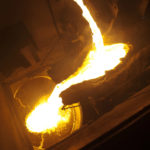Background
Hardenability is the term used to describe the effect of various elements on the transformation characteristics of steels and the resultant microstructure after cooling from the austenitising (or hardening) temperature.
Depth of Hardening
In plain carbon steels the depth of hardening will be shallow, even for small sections given a relatively fast quench rate. As the alloying element content increases so does the depth of hardening. This means that the alloy steels can be hardened in many cases right through sections to the desired microstructures and give optimum service life.
It is at the design stage that these basic considerations should be made and the right steel grade chosen for the application.
Specifying Heat Treatments
In the final analysis, it is the heat treater who is asked to transform an expensive shape into a serviceable product. Remember, it is not the heat treaters function to guess the steel grade or required heat treatment. Full details of the steel grade must be given together with a property specification sheet. By far the most commonly specified property is hardness and it is normally given as a range in either Brinell, Rockwell or Vickers scale. It is normal for the heat treater to hardness test sample components and the area of the component which can be treated for a hardness test should be indicated.
Tensile Strength and Hardness
Analyze Your Metals | Request a Quote
For heat treated steels a relationship exists between tensile strength and hardness. By referring to published figures the hardness values can be converted to tensile strength usually measured in N/mm2 or MPa.
Properties That Can be Affected by Heat Treatment
When service conditions demand higher hardness areas on components to resist wear, abrasion, erosion, indentation or increase fatigue resistance, various treatments can be specified.
Surface Hardening
Case carburisation followed by quench hardening is a process which is well documented and has occupied a leadership role in surface hardening technology for decades. It is still the major surface hardening treatment with wide application in the gear industry and automotive components manufacturing.
Nitriding
Nitriding and various related processes are lower temperature solid state reactions which as a consequence are very valuable for surface hardening items requiring minimal distortion during processing.
By using special steel grades the surface hardness of nitrided components can be very high, say 1100 Vickers compared to 750-800 Vickers for a carburised and quenched structure.
It is important to note that for nitriding to be successful, the steel used should be hardened and tempered or the components should be rough machined then hardened and tempered, usually to a hardness range of HRc 30 – HRc 35. Nitriding must be carded out on a correct microstructure of tempered martensite to minimise the occurrence of spalling.
Flame Hardening
This process consists of hardening the surface of an object by heating it above the transformation temperature using a high intensity flame from a specially designed burner and then progressively quenching it in water, oil or suitable synthetic quenchant. The depth of hardened layer can range from 1 to 10 mm.
A considerable level of skill and understanding is required for the process and depending upon the complexity of the part to be hardened, a large number of variables need to be examined before the job should proceed.
Read more: Hardening of Steels – Surface Hardening, Nitriding, Flame Hardening and Induction Hardening






